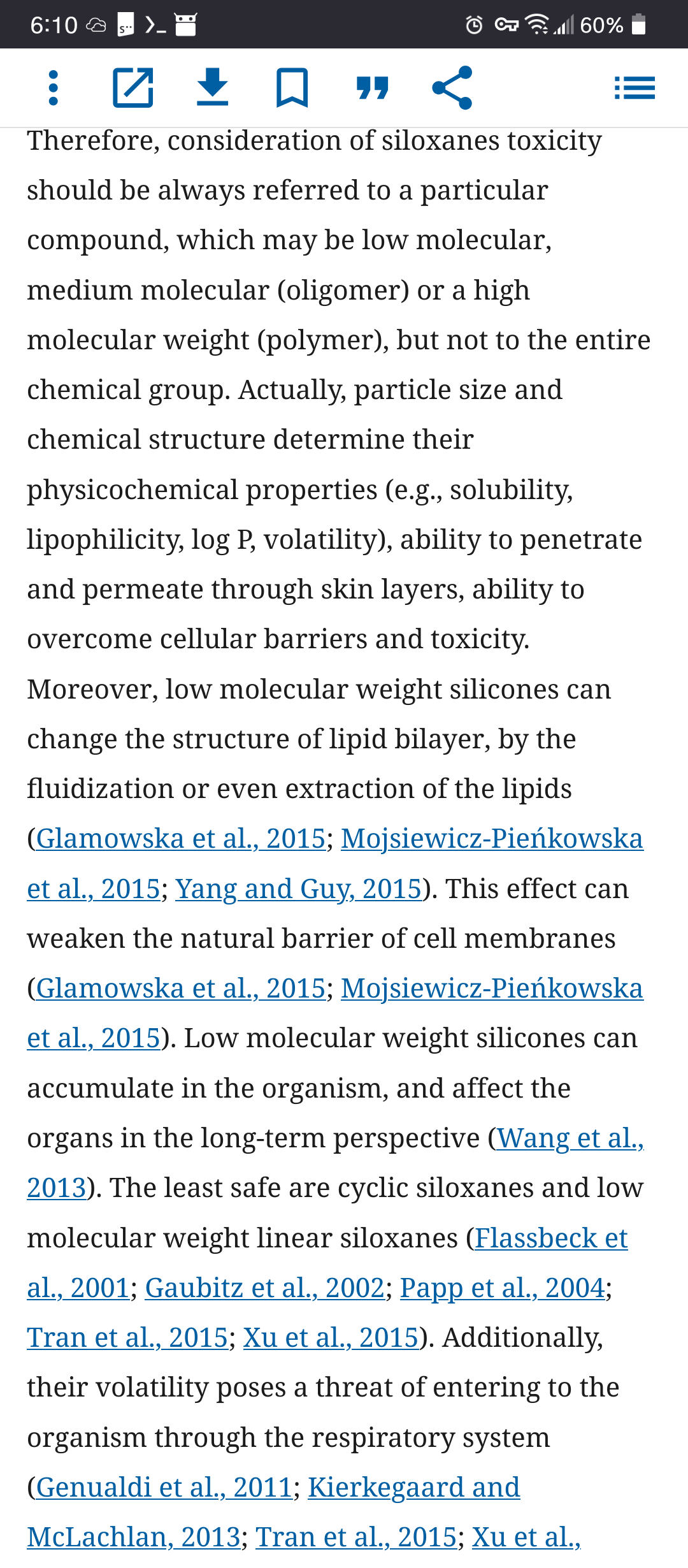- cross-posted to:
- [email protected]
- cross-posted to:
- [email protected]
Missing from the article: actual amounts of PFAS found in the bands, what percentage of it can be absorbed through skin contact, how that compares to other sources the average person might run into, and how much you have to absorb before biological damage emerges out of the statistical noise. The information may be in the original paper, but I’m disinclined to search for it there. Without those numbers, this is meaningless.
From the paper:
The very high concentrations of PFHxA readily extractable from the surfaces of fluoroelastomer watch bands, together with the current limited knowledge on the dermal absorption of PFHxA, demonstrate the need for more comprehensive exposure studies of PFHxA.
So it sounds more like it’s unclear for now. But probably best to about these bands either way.
“Very high”
This is just a news article. Also even though they had those informations in the article I won’t trust some journalist about the answers of your big questions and I suggest you the same.
One of two things is the case:
-
The numbers are in the paper, and the person who wrote the article could have transcribed them but is too lazy.
-
The numbers are not in the paper, in which case I would class the article as inflammatory and irresponsible.
.
Do I trust the journalist? Not in the sense you mean, but I expect them to act responsibly and make a minimum effort.
-
How about typical watch bands? Without comparison, I highly doubt this is only happening on smartwatch bands.
From what I researched, fluoroelastomer is not silicone. Silicone bands are more common.
I am wondering about this, also. I have a regular watch, with a “plastic” band. Why would PFAS be used in these bands? Ridiculous.
If you buy a $10 “fashion watch” from the ugly shiny watch depot at your local dollar mart, odds are you’ll have wrist cancer in a month.
Only watches I own are stainless steel, with stainless, leather, or fabric straps.
Silicone bands are not the same as fluoroelastomer, which is what the article is about. A LOT of bands on Amazon are silicone bands.
They asked about typical watch bands.
I use what I consider typical watch bands.
I don’t worry about what elastomer or poly whatever is in these other bands.
Silicone is not without risk. And products sold on amazon aren’t exactly always as marketed.
https://pmc.ncbi.nlm.nih.gov/articles/PMC4884743/
Anyway, I was commenting on typical.
That article is not at all what you said it was. It is saying medical grade silicone is safe, not that “non-medical” silicone is not.
Generally, siloxanes (silicones) are well tolerated by the human organism, and therefore they are an integral part of innovative methods of treatment, health care and nursing. They are commonly regarded as non-toxic to humans and the environment, or toxic to a very small extend. However, there is a number of publications in which the scientists and experts question this opinion. Many authors demonstrated that the degree of polymerization and the structure affect the ability to overcome cellular barriers, including stratum corneum of the skin and absorption into the organism, migration in the living organism, ability to accumulate, degradability and toxicity. This particularly applies to low molecular weight siloxanes. It can be concluded in the summary, that an evaluation of the safety of siloxanes application should always refer to a particular compound, not a chemical group. Furthermore, the use of low molecular weight silicones should be reduced, as well as the purity of high molecular weight silicones, which may contain low molecular compounds as impurities, should be monitored. It should be emphasized that in the case of silicones for medical and pharmaceutical use, the manufactures of this group of compounds formed a special class, which they called “Medical Grade Silicones” or “Silicones for Healthcare Application.” These silicones must meet certain standards. Medical grade silicones are specially designed, produced and purified, so that to meet the highest requirements of the medical industry. The detailed toxicity data and information about “Medical Grade Silicones” and “Silicones for Healthcare Application” will be given in the next parts of this cycle.
Congratulations on quoting the summary and skipping over
In conclusion, considering the safety of the direct application or contact by humans with siloxanes, the polycondensation reaction is preferred, due to lower contamination with low molecular weight siloxanes of cyclic structure. The literature indicates that they exhibit toxic effects, for example: cancerogenicity, modifications in proteins conformation, influence on the immune system, genotoxicity, skin irritations, intraocular pressure increase and teratogenicity
Trust the maker of that silicone strap on amazon named qxzijhnnnggqqi qzzcni all you want to produce the kind of silicone or whatever other material.
Neither of the cited articles mentions the toxicity at all though. Also, are you sure your “typical” bands are free of heavy metals?
You’re right, nowhere does it mention toxicity, except the entire article.

And you’re right, I am not sure there aren’t any heavy metals in my leather and fabric straps.
And you’re also correct that the stainless straps that I do have which I bought from a jeweler I am additionally uncertain about their contents aside from the manufacturers certification.
But weren’t you talking about silicone?
Problems pointed out by commenters aside, I am under the impression that there is very little oversight about this kind of stuff anymore.
For one thing - unless they’ve changed recently, Amazon “bins” alike products from multiple suppliers, meaning if a bad actor is introducing counterfeits (or just less stringently tested, for more fungible products) - Amazon doesn’t even know who they got them from, by the time that’s discovered.
But for another thing, the absolutely incredible volume of products - how on earth is anyone making sure these random-character-generated “brands” are safe?
I lack much in the way of direct evidence, cuz I’ve got shit to do and this isn’t my life’s focus - but it seems apparent that there cannot possibly be the kind of consumer safety testing that we want going on. And if that’s true, it’s only a matter of time before the smart capitalists realize no one is watching and they can make stuff even cheaper (I think they already have), and then how long before we as a society discover all the harm that’s done as a result?
I’d love to be wrong about this, but like so many tech innovations, I have a feeling we’re going to find out later there were huge harms done before we learned how to rein them in. The speed, volume, and price we’ve grown used to with Amazon seems to preclude consumer safety.
Brands tested:
- Apple
- Apple/Nike
- CASETiFY
- Fitbit
- KingofKings
- Modal
- Samsung
- Tighesen
- Vanjua
I’m not surprised at all. My wife and I only use 3rd party metal bands because the factory bands gave us both chemical burns.
WTF lol
I’m sorry this is going to be such a shit comment, but I worked with a guy that had a fitness watch of some stripe.
He was a heavier guy and well, that plasticy band was pressed tight against his skin. One day he came in with this nasty looking ring of red and peeling skin around his wrist. Said he got a rash from the watch. (It’s very possible it was an allergic reaction to something in the band.)
This is a shit comment because I don’t know the brand, and I’m totally saying “trust me, bro.” But like, trust me, bro, it apparently happens?
No I have seen it happen first hand. To myself and a family member I totally believe it. I had to try several bands to find one that doesn’t cause me issues similar to that but not as severe. This is wild it isn’t more regulated or something.
Can confirm. Fitbit Charge 6 band did that to me until I replaced it with this style:

Yea i know that silicon is a rough material, so I went with a woven cloth band that uses velcro to fasten the strap. Anything is better than that silicon crap.
What about Garmin?
Same question: super weird to leave them out…
Probably means no.
What about the Pinetime?
About a decade ago I had a Fitbit and wearing it caused my wrist to break out in a rash. I sent a picture of said wrist to Customer Support and they gave me a full refund on it.
Now, I’ve not had a watch cause me to break out like that since and I’ve also never owned any of the other brands on this list… Now you got me wondering.
A recent study published in the journal “Environmental Science & Technology Letters” has found that many popular smartwatch bands contain high levels of toxic “forever chemicals” known as PFAS. These chemicals are used in many products, from cookware to clothing, because they make things non-stick or water-resistant. The problem is, they don’t break down in the environment and can build up in our bodies over time. This can lead to some pretty serious health problems like cancer, immune system issues, and even developmental problems in kids.
“But H20 is a chemical!” /s
OH. MY. Oh, I’m not shocked.
what about zswatch?
So don’t eat my watch band. Noted.
“This chemical can be absorbed through your skin, and it’s even worse if you’re sweating while wearing the band because it can get into your pores”
So you’re saying the lemmite can eat it?
ONLY if they aren’t sweaty.
You’d be surprised at what your skin just… absorbs
Ok. Don’t eat the watches.









